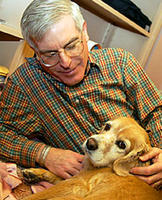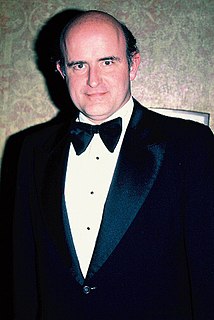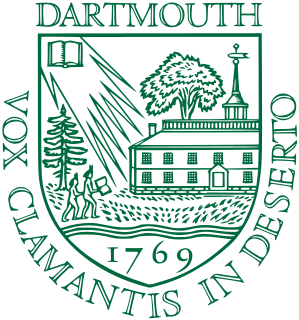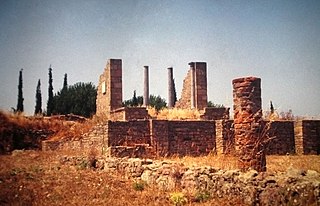
Pseudoarchaeology—also known as alternative archaeology, fringe archaeology, fantastic archaeology, or cult archaeology—refers to interpretations of the past from outside of the archaeological science community, which reject the accepted datagathering and analytical methods of the discipline. These pseudoscientific interpretations involve the use of artifacts, sites or materials to construct scientifically insubstantial theories to supplement the pseudoarchaeologists' claims. Methods include exaggeration of evidence, dramatic or romanticized conclusions, and fabrication of evidence.

Kazimierz Józef Marian Michałowski was a Polish archaeologist and Egyptologist, art historian, member of the Polish Academy of Sciences, professor ordinarius of the University of Warsaw as well as the founder of the Polish school of Mediterranean archaeology and a precursor of Nubiology.
Brian Murray Fagan is a prolific British author of popular archaeology books and a professor emeritus of Anthropology at the University of California, Santa Barbara.

Hylates was a god worshipped on the island of Cyprus who was later likened to the Greek God Apollo. His name probably derives from ὑλακτέω [ʰylaktéō] „barking“ or ὕλη [ʰýlē] „forest“, which is why Lebek calls him Apollo of the woods. He was worshipped from the 3rd century BC until the 3rd century AD.
The year 2000 in archaeology included many events, some of which are listed below.
Sir Cyril Fred Fox was an English archaeologist.
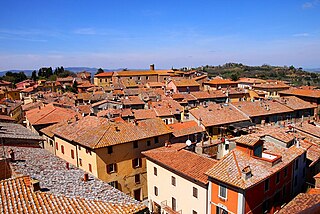
Chiusi is a town and comune in province of Siena, Tuscany, Italy.

Ranuccio Bianchi Bandinelli was an Italian archaeologist and art historian.
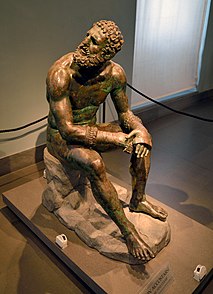
The bronze Boxer at Rest, also known as the Terme Boxer or Boxer of the Quirinal, is a Hellenistic Greek sculpture of a sitting nude boxer at rest, still wearing his caestus, a type of leather hand-wrap. It has been given various dates within the period of about 330 to 50 BCE. It was excavated in Rome in 1885, and is now in the collection of the National Museum of Rome, normally displayed in the Palazzo Massimo alle Terme.

Chianciano Terme is a comune (municipality) in the Province of Siena in the Italian region Tuscany, located about 90 kilometres (56 mi) southeast of Florence and about 50 kilometres (31 mi) southeast of Siena. It is located between the Valdichiana and the Val d'Orcia.

The Capitoline Venus is a type of statue of Venus, specifically one of several Venus Pudica types, of which several examples exist. The type ultimately derives from the Aphrodite of Cnidus. The Capitoline Venus and her variants are recognisable from the position of the arms—standing after a bath, Venus begins to cover her breasts with her right hand, and her groin with her left hand.

The Suburban Baths are located in Pompeii, Italy. Pompeii was destroyed on August 24, 79 AD when Mount Vesuvius erupted, burying the entire city and consequently preserving them.

The National Archaeological Museum of Florence is an archaeological museum in Florence, Italy. It is located at 1 piazza Santissima Annunziata, in the Palazzo della Crocetta.
The Pontifical Commission of Sacred Archaeology is an official board of the Vatican founded in 1852 by Pope Pius IX for the purpose of promoting and directing excavations in the Catacombs of Rome and on other sites of Christian antiquarian interest, and of safeguarding the objects found during such excavations. In 1925, Pope Pius XI declared that the Commission was Pontifical and its competencies were defined in detail and reaffirmed recently in the conventions between the Holy See and the Italian State.

The Florence–Rome railway is part of the traditional main north-south trunk line of the Italian railway network. The line is referred to by Ferrovie dello Stato as the Linea Lenta to distinguish it from the parallel high-speed line. The Linea Lenta is now mainly used for regional services, for the InterCity services — rather than the faster Le Frecce trains — between Florence and Rome and for the majority of freight trains. Some types of passenger train are routed on the line to serve smaller stations not served by the high-speed line or in order to improve traffic flow during peak periods or other periods of congestion.

Gino Vinicio Gentili was an Italian archaeologist.

Terina was an ancient city of Magna Graecia on the north shore of the Gulf of Saint Euphemia, about 20 km (12 mi) from Lamezia Terme in Calabria. The site of the city was allegedly found in 1922 by the archaeologist Paolo Orsi near the modern village of Sant'Eufemia Vetere, but a systematic archaeological investigation was only started in 1997 and it is only based on coins found there. Coins, inscriptions and other artefacts retrieved from the site can be seen in the Museo Archeologico Lametino in Lamezia Terme. However, the actual collocation of the ancient city is in Nocera Terinese where the original location is situated on top of a hill called Piano di Tirena. This hill is surrounded by two rivers merging, Savuto and Grande, and it perfectly matches the description provided by the Greek historian Strabo in his major work Geographica, which was first published around 20 AD.

Roman Cyprus was a minor senatorial province within the Roman Empire. While it was a small province, it possessed several well known religious sanctuaries and figured prominently in Eastern Mediterranean trade, particularly the production and trade of Cypriot copper. As it was situated at a strategically important position along Eastern Mediterranean trade routes, Cyprus was controlled by imperial powers throughout the first millennium B.C. including: the Assyrians, Egyptians, Macedonians, and in particular the Romans. Cyprus was annexed by the Romans in 58 B.C., but until 22 B.C. when Cyprus became an official senatorial province, control over the island fluctuated between the Romans and the Ptolemaic Empire. From the Battle of Actium in 31 BC until the 7th century Cyprus was controlled by the Romans. Cyprus officially became part of the Eastern Roman Empire in 293 AD.
Roberto Gagliardi is an Italian-born art dealer based in London. He has a gallery in London and has founded as well as curated a temporary exhibition in Chelsea Old Town Hall called London Art Biennale. His art collection is housed in the Museo d'Arte di Chianciano Terme in Chianciano Terme, in Tuscany, central Italy; which since 2009 has organised the Biennale di Chianciano in the town.
